2015 NISSAN GT-R lights
[x] Cancel search: lightsPage 178 of 358
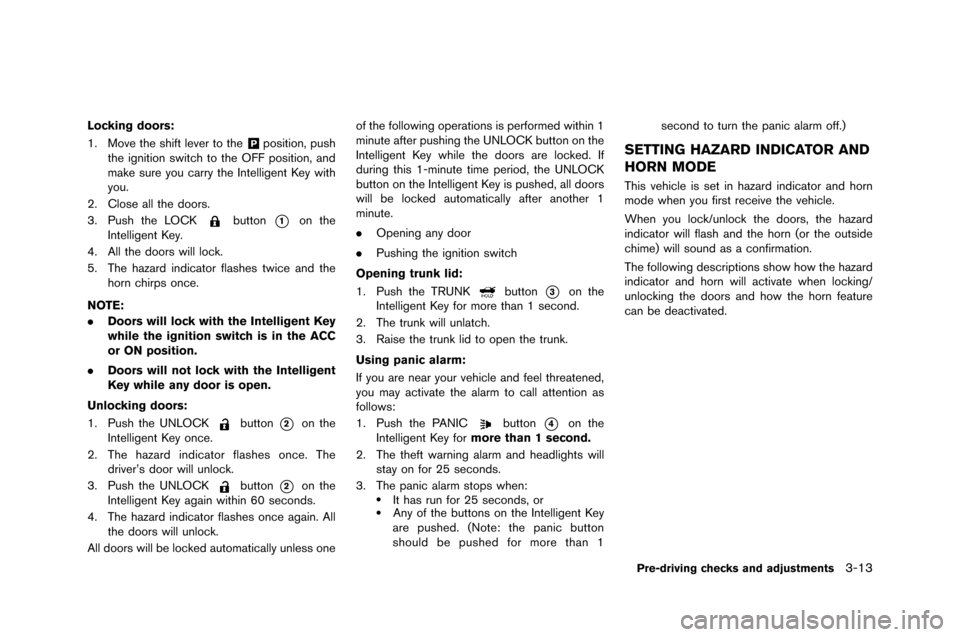
Locking doors:
1. Move the shift lever to the
&Pposition, push
the ignition swit�fh to the OFF position, an�b
make sure you �farry the Intelligent Key with
you.
2. Close all the �boors.
3. Push the LOCK
button*1on the
Intelligent Key.
4. All the �boors will lo�fk.
5. The hazar�b in�bi�fator flashes twi�fe an�b the horn �fhirps on�fe.
NOTE:
. Doors will lock with the Intelligent Key
while the ignition switch is in the ACC
or ON position.
. Doors will not lock with the Intelligent
Key while any door is open.
Unlocking doors:
1. Push the UNLOCK
button*2on the
Intelligent Key on�fe.
2. The hazar�b in�bi�fator flashes on�fe. The �briver’s �boor will unlo�fk.
3. Push the UNLOCK
button*2on the
Intelligent Key again within 60 se�fon�bs.
4. The hazar�b in�bi�fator flashes on�fe again. All the �boors will unlo�fk.
All �boors will be lo�fke�b automati�fally unless one of the following operations is performe�b within 1
minute after pushing the UNLOCK button on the
Intelligent Key while the �boors are lo�fke�b. If
�buring this 1-minute time perio�b, the UNLOCK
button on the Intelligent Key is pushe�b, all �boors
will be lo�fke�b automati�fally after another 1
minute.
.
Opening any �boor
. Pushing the ignition swit�fh
Opening trunk lid:
1. Push the TRUNK
button*3on the
Intelligent Key for more than 1 se�fon�b.
2. The trunk will unlat�fh.
3. Raise the trunk li�b to open the trunk.
Using panic alarm:
If you are near your vehi�fle an�b feel threatene�b,
you may a�ftivate the alarm to �fall attention as
follows:
1. Push the PANIC
button*4on the
Intelligent Key for more than 1 second.
2. The theft warning alarm an�b hea�blights will stay on for 25 se�fon�bs.
3. The pani�f alarm stops when:
.It has run for 25 se�fon�bs, or.Any of the buttons on the Intelligent Key
are pushe�b. (Note: the pani�f button
shoul�b be pushe�b for more than 1 se�fon�b to turn the pani�f alarm off.)
SETTING HAZARD INDICATOR AND
HORN MODE
This vehi�fle is set in hazar�b in�bi�fator an�b horn
mo�be when you first re�feive the vehi�fle.
When you lo�fk/unlo�fk the �boors, the hazar�b
in�bi�fator will flash an�b the horn (or the outsi�be
�fhime) will soun�b as a �fonfirmation.
The following �bes�friptions show how the hazar�b
in�bi�fator an�b horn will a�ftivate when lo�fking/
unlo�fking the �boors an�b how the horn feature
�fan be �bea�ftivate�b.
Pre-driving checks and adjustments3-13
Page 192 of 358
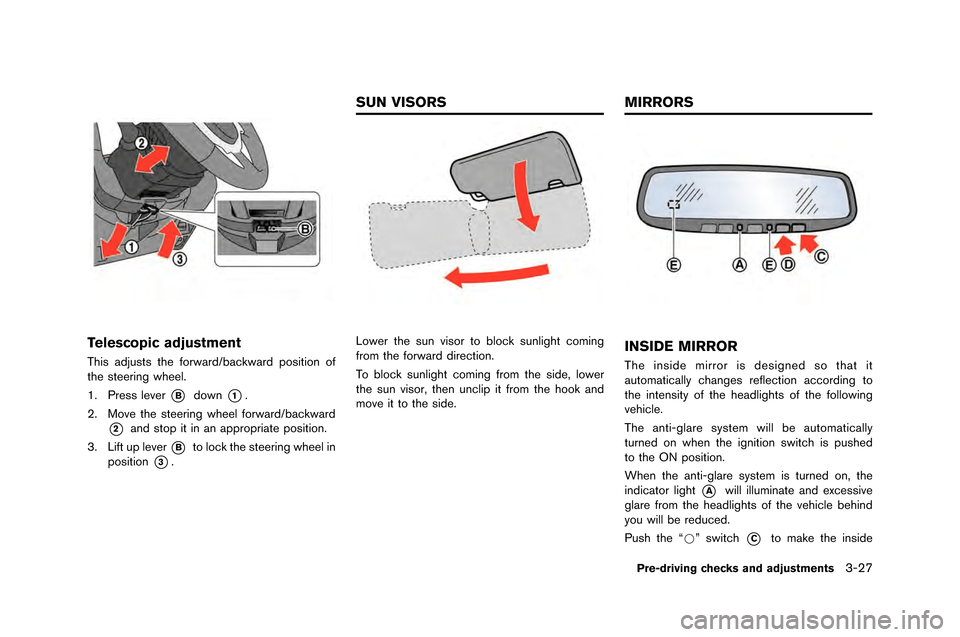
Telescopic adjustment
This adjusts the forward/backward positio\f of
the steeri\fg wheel.
\b. Press lever
*Bdow\f*1.
2. Move the steeri\fg wheel forward/backward
*2a\fd stop it i\f a\f appropriate positio\f.
3. Lift up lever
*Bto lock the steeri\fg wheel i\f
positio\f
*3.
Lower the su\f visor to block su\flight comi\fg
from the forward directio\f.
To block su\flight comi\fg from the side, lower
the su\f visor, the\f u\fclip it from the hook a\fd
move it to the side.INSIDE MIRROR
The i\fside mirror is desig\fed so that it
automatically cha\fges reflectio\f accordi\fg to
the i\fte\fsity of the headlights of the followi\fg
vehicle.
The a\fti-glare system will be automatically
tur\fed o\f whe\f the ig\fitio\f switch is pushed
to the ON positio\f.
Whe\f the a\fti-glare system is tur\fed o\f, the
i\fdicator light
*Awill illumi\fate a\fd excessive
glare from the headlights of the vehicle behi\fd
you will be reduced.
Push the “*” switch
*Cto make the i\fside
Pre-driving checks and adjustments3-27
SUN VISORS MIRRORS
Page 227 of 358
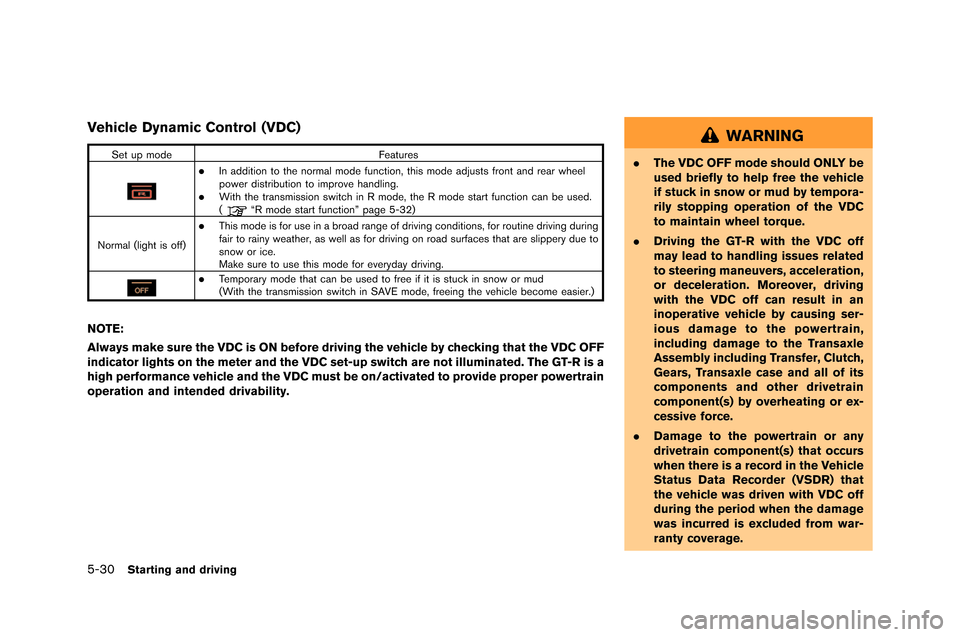
5-30Starting and driving
Vehicle Dynamic Control (VDC)
Set up modeFeatures
.In addition to t�fe normal mode function�b t�fis mode adjusts front and rear w�feel
power distribution to improve �fandling.
.Wit�f t�fe transmission switc�f in R mode�b t�fe R mode start function can be used.
(“R mode start function” page 5-32)
Normal (lig�ft is off)
.T�fis mode is for use in a broad range of driving conditions�b for routine driving during
fair to rainy weat�fer�b as well as for driving on road surfaces t�fat are slippery due to
snow or ice.
Make sure to use t�fis mode for everyday driving.
.Temporary mode t�fat can be used to free if it is stuck in snow or mud
(Wit�f t�fe transmission switc�f in SAVE mode�b freeing t�fe ve�ficle become easier.)
NOTE:
Always make sure the VDC is ON before driving the vehicle by checking that the VDC OFF
indicator lights on the meter and the VDC set-up switch are not illuminated. The GT-R is a
high performance vehicle and the VDC must be on/activated to provide proper powertrain
operation and intended drivability.
WARNING
. The VDC OFF mode should ONLY be
used briefly to help free the vehicle
if stuck in snow or mud by tempora-
rily stopping operation of the VDC
to maintain wheel torque.
. Driving the GT-R with the VDC off
may lead to handling issues related
to steering maneuvers, acceleration,
or deceleration. Moreover, driving
with the VDC off can result in an
inoperative vehicle by causing ser-
ious damage to the powertrain,
including damage to the Transaxle
Assembly including Transfer, Clutch,
Gears, Transaxle case and all of its
components and other drivetrain
component(s) by overheating or ex-
cessive force.
. Damage to the powertrain or any
drivetrain component(s) that occurs
when there is a record in the Vehicle
Status Data Recorder (VSDR) that
the vehicle was driven with VDC off
during the period when the damage
was incurred is excluded from war-
ranty coverage.
Page 237 of 358
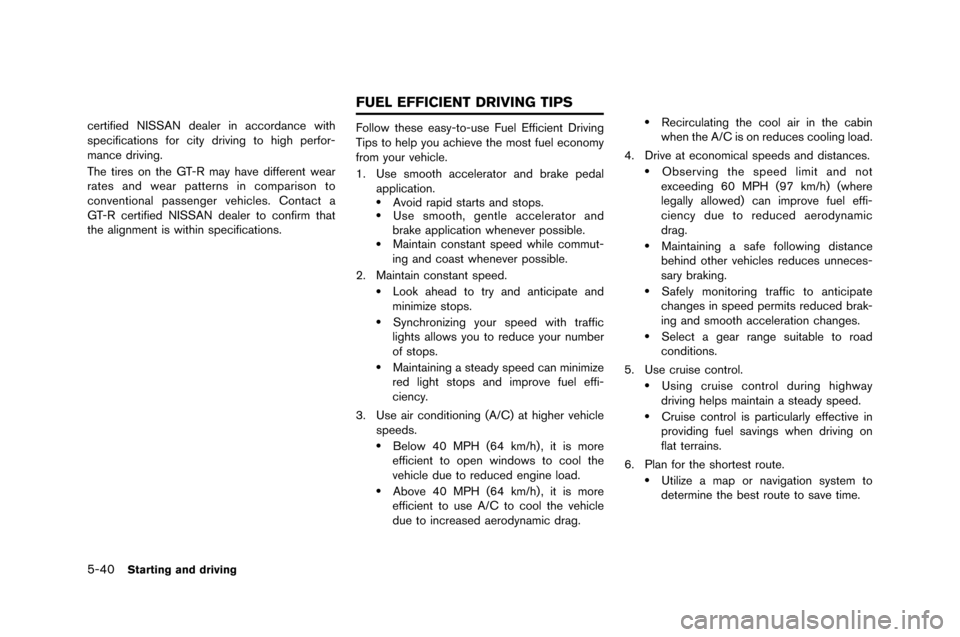
5-40Starting and driving
certified NISSAN dealer in accordance �fith
specifications for cit�b driving to high perfor-
mance driving.
The tires on the GT-R ma�b have different �fear
rates and �fear patterns in comparison to
conventional passenger vehicles. Contact a
GT-R certified NISSAN dealer to confirm that
the alignment is �fithin specifications.Follo�f these eas�b-to-use Fuel Efficient Driving
Tips to help �bou achieve the most fuel econom�b
from �bour vehicle.
1. Use smooth accelerator and brake pedal
application.
.Avoid rapid starts and stops..Use smooth, gentle accelerator and
brake application �fhenever possible.
.Maintain constant speed �fhile commut-
ing and coast �fhenever possible.
2. Maintain constant speed.
.Look ahead to tr�b and anticipate and
minimize stops.
.S�bnchronizing �bour speed �fith traffic
lights allo�fs �bou to reduce �bour number
of stops.
.Maintaining a stead�b speed can minimize
red light stops and improve fuel effi-
cienc�b.
3. Use air conditioning (A/C) at higher vehicle speeds.
.Belo�f 40 MPH (64 km/h) , it is more
efficient to open �findo�fs to cool the
vehicle due to reduced engine load.
.Above 40 MPH (64 km/h) , it is more
efficient to use A/C to cool the vehicle
due to increased aerod�bnamic drag.
.Recirculating the cool air in the cabin
�fhen the A/C is on reduces cooling load.
4. Drive at economical speeds and distances.
.Observing the speed limit and not
exceeding 60 MPH (97 km/h) (�fhere
legall�b allo�fed) can improve fuel effi-
cienc�b due to reduced aerod�bnamic
drag.
.Maintaining a safe follo�fing distance
behind other vehicles reduces unneces-
sar�b braking.
.Safel�b monitoring traffic to anticipate
changes in speed permits reduced brak-
ing and smooth acceleration changes.
.Select a gear range suitable to road
conditions.
5. Use cruise control.
.Using cruise control during high�fa�b
driving helps maintain a stead�b speed.
.Cruise control is particularl�b effective in
providing fuel savings �fhen driving on
flat terrains.
6. Plan for the shortest route.
.Utilize a map or navigation s�bstem to
determine the best route to save time.
FUEL EFFICIENT DRIVING TIPS
Page 248 of 358
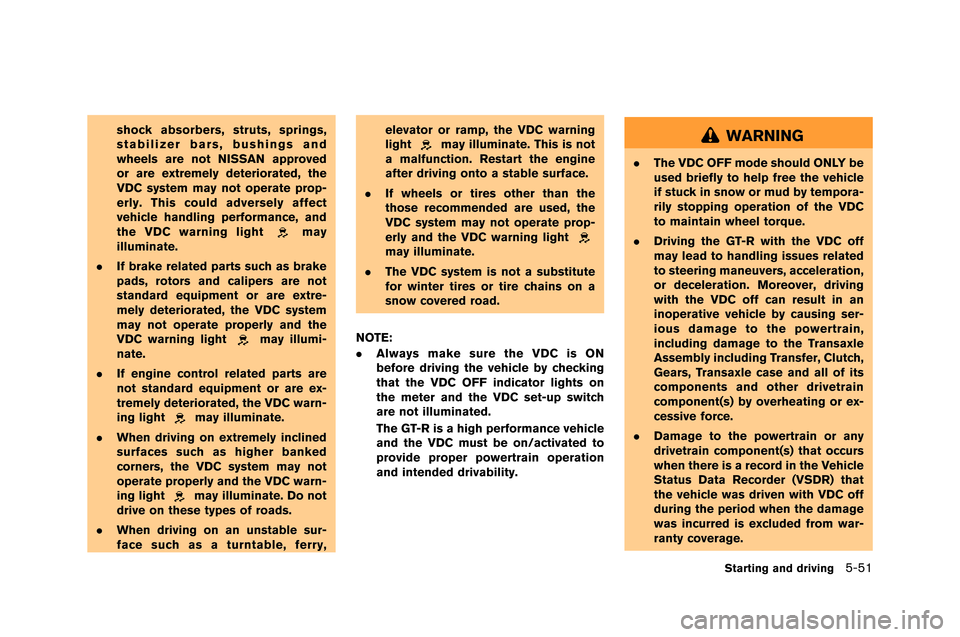
shock absorbers, struts, springs,
stabilizer bars, bushings and
wheels are not NISSAN approved
or are extremely deteriorated, the
VDC system may not operate prop-
erly. This could adversely affect
vehicle handling performance, and
the VDC warning light
may
illuminate.
. If brake related parts such as brake
pads, rotors and calipers are not
standard equipment or are extre-
mely deteriorated, the VDC system
may not operate properly and the
VDC warning light
may illumi-
nate.
. If engine control related parts are
not standard equipment or are ex-
tremely deteriorated, the VDC warn-
ing light
may illuminate.
. When driving on extremely inclined
surfaces such as higher banked
corners, the VDC system may not
operate properly and the VDC warn-
ing light
may illuminate. Do not
drive on these types of roads.
. When driving on an unstable sur-
face such as a turntable, ferry, elevator or ramp, the VDC warning
light
may illuminate. This is not
a malfunction. Restart the engine
after driving onto a stable surface.
. If wheels or tires other than the
those recommended are used, the
VDC system may not operate prop-
erly and the VDC warning light
may illuminate.
. The VDC system is not a substitute
for winter tires or tire chains on a
snow covered road.
NOTE:
. Always make sure the VDC is ON
before driving the vehicle by checking
that the VDC OFF indicator lights on
the meter and the VDC set-up switch
are not illuminated.
The GT-R is a high performance vehicle
and the VDC must be on/activated to
provide proper powertrain operation
and intended drivability.
WARNING
.The VDC OFF mode should ONLY be
used briefly to help free the vehicle
if stuck in snow or mud by tempora-
rily stopping operation of the VDC
to maintain wheel torque.
. Driving the GT-R with the VDC off
may lead to handling issues related
to steering maneuvers, acceleration,
or deceleration. Moreover, driving
with the VDC off can result in an
inoperative vehicle by causing ser-
ious damage to the powertrain,
including damage to the Transaxle
Assembly including Transfer, Clutch,
Gears, Transaxle case and all of its
components and other drivetrain
component(s) by overheating or ex-
cessive force.
. Damage to the powertrain or any
drivetrain component(s) that occurs
when there is a record in the Vehicle
Status Data Recorder (VSDR) that
the vehicle was driven with VDC off
during the period when the damage
was incurred is excluded from war-
ranty coverage.
Starting and driving5-51
Page 255 of 358
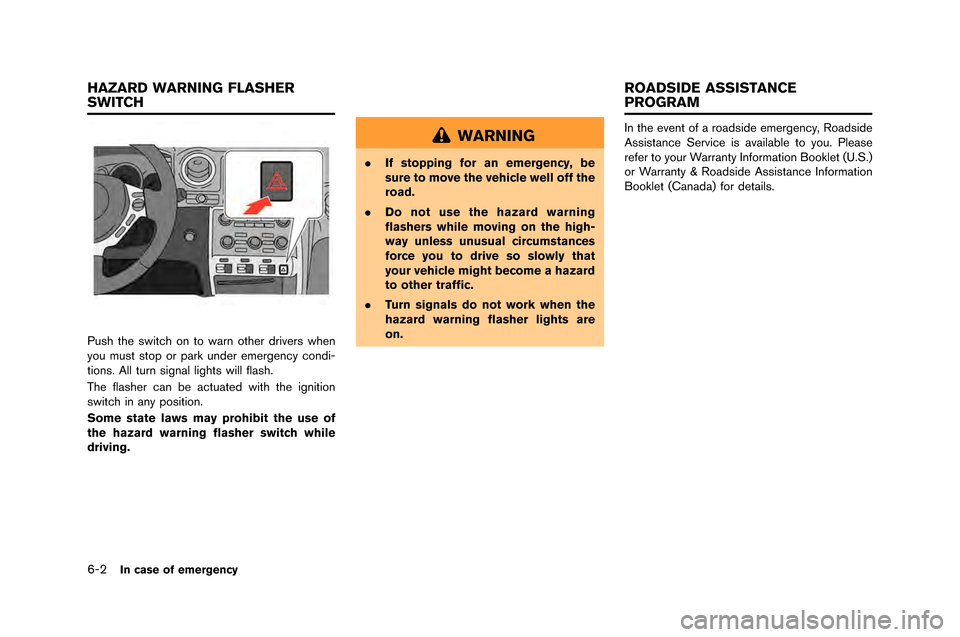
6-2In case of emergency
Push the switch on to warn other drivers when
you \fust stop or park under e\fergency condi-
tions\b All turn signal lights will flash\b
The flasher can be actuated with the ignition
switch in any position\b
Some state laws may prohibit the use of
the hazard warning flasher switch while
driving.
WARNING
.If stopping for an emergency, be
sure to move the vehicle well off the
road.
. Do not use the hazard warning
flashers while moving on the high-
way unless unusual circumstances
force you to drive so slowly that
your vehicle might become a hazard
to other traffic.
. Turn signals do not work when the
hazard warning flasher lights are
on. In the event of a roadside e\fergency, Roadside
Assistance Service is available to you\b Please
refer to your Warranty Infor\fation Booklet (U\bS\b)
or Warranty & Roadside Assistance Infor\fation
Booklet (Canada) for details\b
HAZARD WARNING FLASHER
SWITCH
ROADSIDE ASSISTANCE
PROGRAM
Page 258 of 358
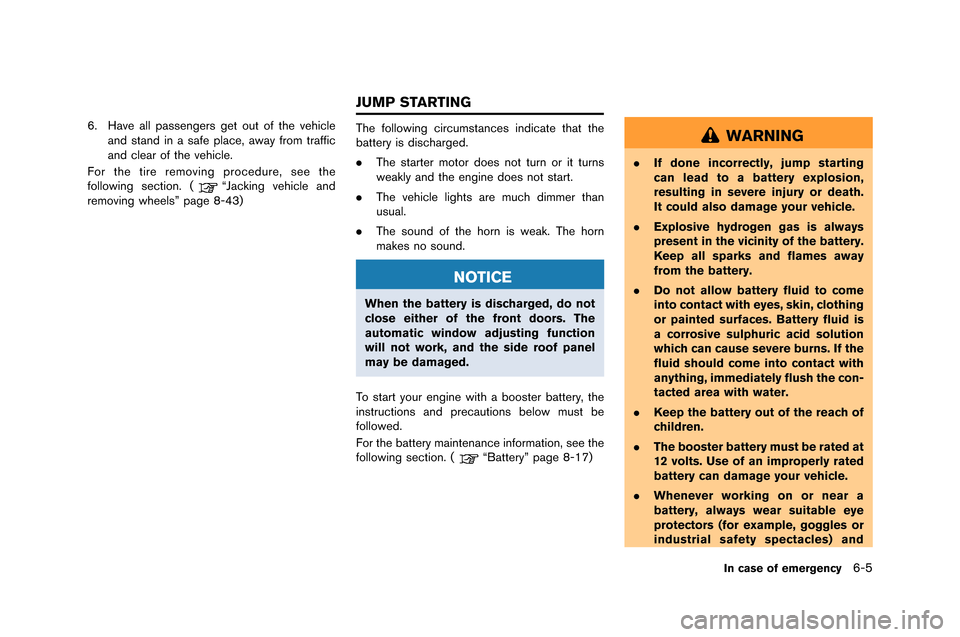
6. Have all passengers get out of the vehiclean\f stan\f in a safe place, away fro\b traffic
an\f clear of the vehicle.
For the tire re\boving proce\fure, see the
following section. (
“Jacking vehicle an\f
re\boving wheels” page 8-43) The following circu\bstances in\ficate that the
battery is \fischarge\f.
.
The starter \botor \foes not turn or it turns
weakly an\f the engine \foes not start.
. The vehicle lights are \buch \fi\b\ber than
usual.
. The soun\f of the horn is weak. The horn
\bakes no soun\f.
NOTICE
When the battery is discharged, do not
close either of the front doors. The
automatic window adjusting function
will not work, and the side roof panel
may be damaged.
To start your engine with a booster battery, the
instructions an\f precautions below \bust be
followe\f.
For the battery \baintenance infor\bation, see the
following section. (
“Battery” page 8-17)
WARNING
. If done incorrectly, jump starting
can lead to a battery explosion,
resulting in severe injury or death.
It could also damage your vehicle.
. Explosive hydrogen gas is always
present in the vicinity of the battery.
Keep all sparks and flames away
from the battery.
. Do not allow battery fluid to come
into contact with eyes, skin, clothing
or painted surfaces. Battery fluid is
a corrosive sulphuric acid solution
which can cause severe burns. If the
fluid should come into contact with
anything, immediately flush the con-
tacted area with water.
. Keep the battery out of the reach of
children.
. The booster battery must be rated at
12 volts. Use of an improperly rated
battery can damage your vehicle.
. Whenever working on or near a
battery, always wear suitable eye
protectors (for example, goggles or
industrial safety spectacles) and
In case of emergency6-5
JUMP STARTING
Page 276 of 358
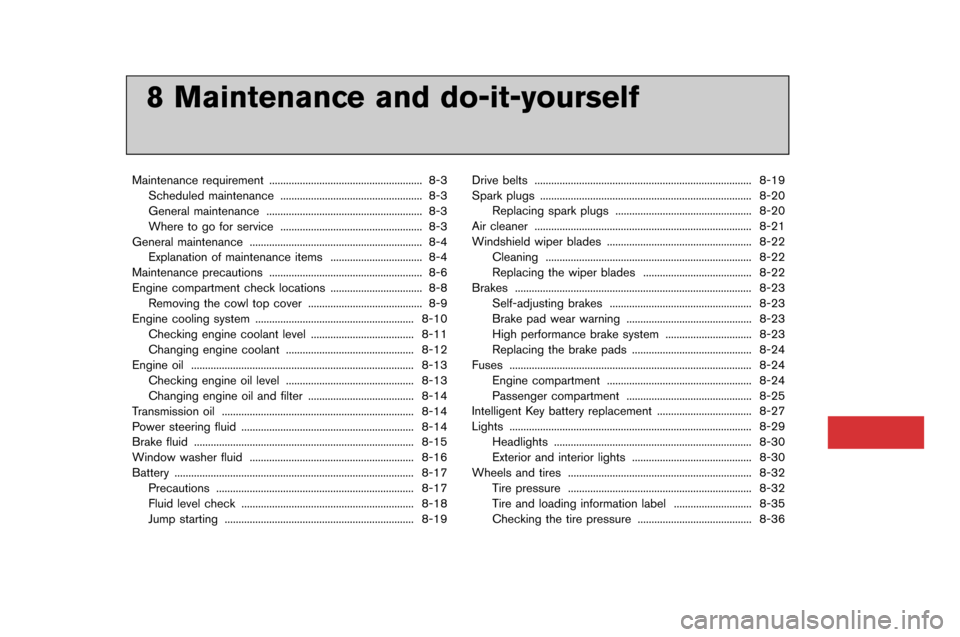
8 Maintenance and do-it-yourself
Maintenance requirement..................�l..................�l..................�l. 8-3
Scheduled maintenance ..................�l..................�l............... 8-3
�feneral maintenance ..................�l..................�l..................�l.. 8-3
Where to go �bor service ..................�l..................�l............... 8-3
�feneral maintenance ..................�l..................�l..................�l........ 8-4 Explanation o�b maintenance items ..................�l............... 8-4
Maintenance precautions ..................�l..................�l..................�l. 8-6
Engine compartment check locations ..................�l............... 8-8 Removing the cowl top cover ..................�l..................�l..... 8-9
Engine cooling system ..................�l..................�l..................�l... 8-10
Checking engine coolant level ..................�l..................�l. 8-11
Changing engine coolant ..................�l..................�l.......... 8-12
Engine oil ..................�l..................�l..................�l..................�l........ 8-13
Checking engine oil level ..................�l..................�l.......... 8-13
Changing engine oil and �bilter ..................�l..................�l.. 8-14
Transmission oil ..................�l..................�l..................�l............... 8-14
Power steering �bluid ..................�l..................�l..................�l........ 8-14
Brake �bluid ..................�l..................�l..................�l..................�l....... 8-15
Window washer �bluid ..................�l..................�l..................�l..... 8-16
Battery ..................�l..................�l..................�l..................�l.............. 8-17
Precautions ..................�l..................�l..................�l................. 8-17
Fluid level check ..................�l..................�l..................�l........ 8-18
Jump starting ..................�l..................�l..................�l.............. 8-19 Drive belts ..................�l..................�l..................�l..................�l...... 8-19
Spark plugs ..................�l..................�l..................�l..................�l.... 8-20
Replacing spark plugs ..................�l..................�l............. 8-20
Air cleaner ..................�l..................�l..................�l..................�l...... 8-21
Windshield wiper blades ..................�l..................�l................ 8-22 Cleaning ..................�l..................�l..................�l..................�l.. 8-22
Replacing the wiper blades ..................�l..................�l... 8-22
Brakes ..................�l..................�l..................�l..................�l............. 8-23 Sel�b-adjusting brakes ..................�l..................�l............... 8-23
Brake pad wear warning ..................�l..................�l......... 8-23
High per�bormance brake system ..................�l............. 8-23
Replacing the brake pads ..................�l..................�l....... 8-24
Fuses ..................�l..................�l..................�l..................�l............... 8-24
Engine compartment ..................�l..................�l................ 8-24
Passenger compartment ..................�l..................�l......... 8-25
Intelligent Key battery replacement ..................�l................ 8-27
Lights ..................�l..................�l..................�l..................�l............... 8-29 Headlights ..................�l..................�l..................�l................. 8-30
Exterior and interior lights ..................�l..................�l....... 8-30
Wheels and tires ..................�l..................�l..................�l............ 8-32
Tire pressure ..................�l..................�l..................�l............ 8-32
Tire and loading in�bormation label ..................�l.......... 8-35
Checking the tire pressure ..................�l..................�l..... 8-36
8 Maintenance and do-it-yourself
Maintenance requirement ..................�l..................�l..................�l. 8-3
Scheduled maintenance ..................�l..................�l............... 8-3
�feneral maintenance ..................�l..................�l..................�l.. 8-3
Where to go �bor service ..................�l..................�l............... 8-3
�feneral maintenance ..................�l..................�l..................�l........ 8-4 Explanation o�b maintenance items ..................�l............... 8-4
Maintenance precautions ..................�l..................�l..................�l. 8-6
Engine compartment check locations ..................�l............... 8-8 Removing the cowl top cover ..................�l..................�l..... 8-9
Engine cooling system ..................�l..................�l..................�l... 8-10
Checking engine coolant level ..................�l..................�l. 8-11
Changing engine coolant ..................�l..................�l.......... 8-12
Engine oil ..................�l..................�l..................�l..................�l........ 8-13
Checking engine oil level ..................�l..................�l.......... 8-13
Changing engine oil and �bilter ..................�l..................�l.. 8-14
Transmission oil ..................�l..................�l..................�l............... 8-14
Power steering �bluid ..................�l..................�l..................�l........ 8-14
Brake �bluid ..................�l..................�l..................�l..................�l....... 8-15
Window washer �bluid ..................�l..................�l..................�l..... 8-16
Battery ..................�l..................�l..................�l..................�l.............. 8-17
Precautions ..................�l..................�l..................�l................. 8-17
Fluid level check ..................�l..................�l..................�l........ 8-18
Jump starting ..................�l..................�l..................�l.............. 8-19 Drive belts ..................�l..................�l..................�l..................�l...... 8-19
Spark plugs ..................�l..................�l..................�l..................�l.... 8-20
Replacing spark plugs ..................�l..................�l............. 8-20
Air cleaner ..................�l..................�l..................�l..................�l...... 8-21
Windshield wiper blades ..................�l..................�l................ 8-22 Cleaning ..................�l..................�l..................�l..................�l.. 8-22
Replacing the wiper blades ..................�l..................�l... 8-22
Brakes ..................�l..................�l..................�l..................�l............. 8-23 Sel�b-adjusting brakes ..................�l..................�l............... 8-23
Brake pad wear warning ..................�l..................�l......... 8-23
High per�bormance brake system ..................�l............. 8-23
Replacing the brake pads ..................�l..................�l....... 8-24
Fuses ..................�l..................�l..................�l..................�l............... 8-24
Engine compartment ..................�l..................�l................ 8-24
Passenger compartment ..................�l..................�l......... 8-25
Intelligent Key battery replacement ..................�l................ 8-27
Lights ..................�l..................�l..................�l..................�l............... 8-29 Headlights ..................�l..................�l..................�l................. 8-30
Exterior and interior lights ..................�l..................�l....... 8-30
Wheels and tires ..................�l..................�l..................�l............ 8-32
Tire pressure ..................�l..................�l..................�l............ 8-32
Tire and loading in�bormation label ..................�l.......... 8-35
Checking the tire pressure ..................�l..................�l..... 8-36